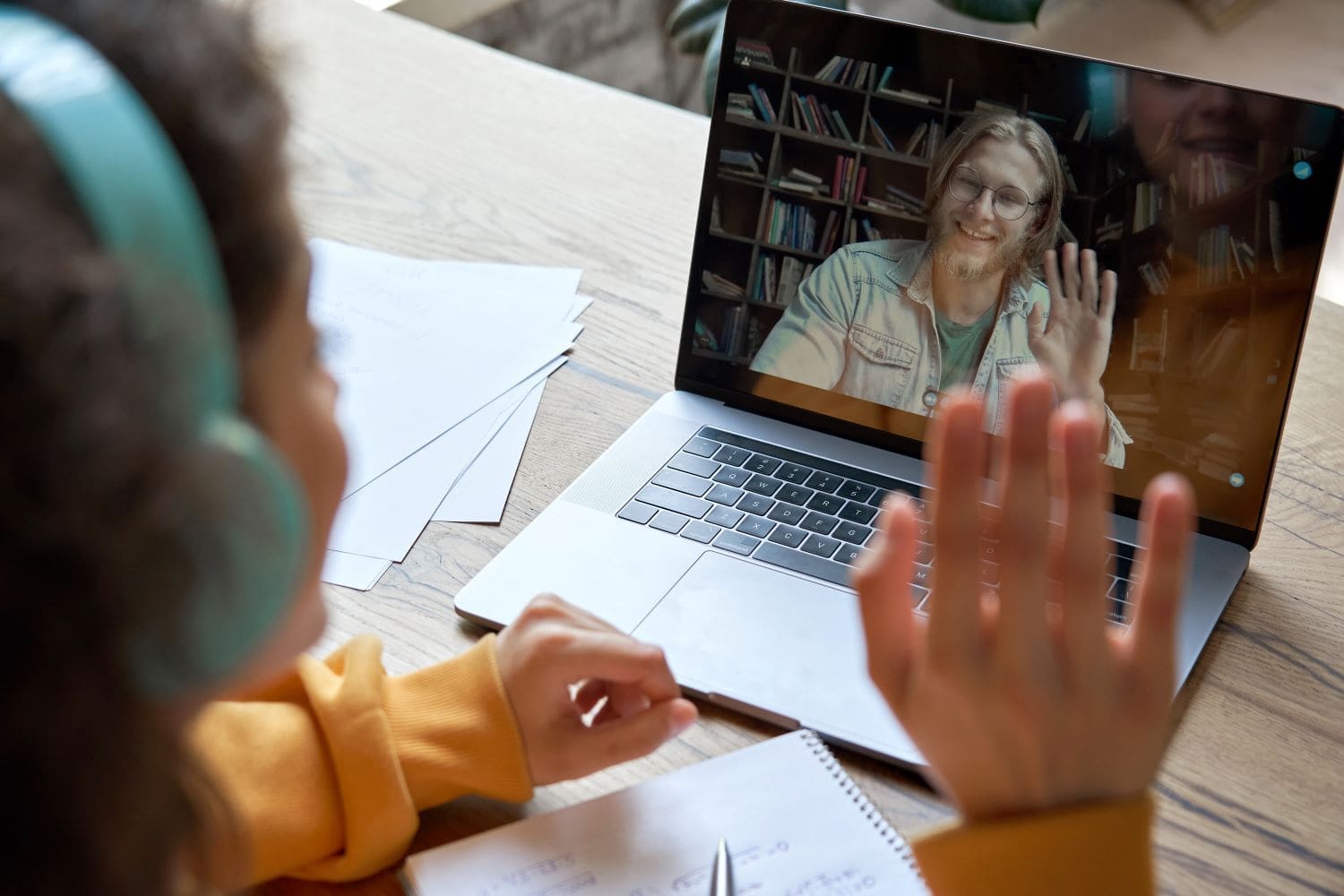In this post
In a modern, fast-paced and digital world, having the ability to undertake education flexibly is becoming increasingly important. Flexible learning caters to individual learning needs, supports lifelong learning, enhances global accessibility and offers economic viability. This adaptability ensures that education remains relevant and accessible to all, regardless of their circumstances or locations.
More people are embarking on their own learning journeys. The Learning and Work Institute’s Adult Participation in Learning Survey 2023 found that almost one in two adults participated in learning in the last three years, the highest rate since the survey began in 1996. The increase in participation since the pandemic has been driven by a rise in self-directed learning, including online. However, in-person classes are here to stay, and millions of people still learn in these environments (Department for Education).
The debate between online learning vs. in-person classes has become more intense, especially since the COVID-19 pandemic. The argument often hinges on personal preferences, circumstances, and individual learning styles. For some, the structure and social environment of in-person classes are crucial, while others thrive in the flexibility and self-directed nature of online learning.
If you are currently considering undertaking a course and are unsure whether to choose online learning or in-person classes, this blog aims to help you choose the best fit for your learning goals and lifestyle.
What Defines Online and In-Person Learning?
Online learning is sometimes known as digital learning, as the content is delivered via digital platforms. It may also be referred to as e-learning, distance learning or remote learning. It is characterised by flexibility and self-paced formats and can accommodate various schedules and learning paces. Students can learn anywhere and at any time. They access course materials, interact with tutors and complete assignments remotely, typically from their homes.
Some examples of online learning include:
- Massive open online courses (MOOCs) – designed for large-scale participation and open access. They cover a wide variety of subjects and are often self-paced.
- Virtual classrooms – mimic traditional classroom settings, allowing real-time interaction between students and tutors through video conferencing tools like Zoom or Microsoft Teams.
- Interactive modules – courses often include interactive elements, such as quizzes, simulations and activities, that engage learners and reinforce the material.
- Video lectures – pre-recorded sessions that students can watch at their own convenience. They offer flexibility and can be paused, replayed and watched multiple times.
- Discussion forums – online forums that allow students to interact with peers and educators, fostering a sense of community and collaboration, e.g. Moodle.
In-person learning is an alternative to online learning. It is also known as traditional or face-to-face learning that involves students and educators physically being present in a classroom or educational setting, such as a campus-based setup. This method emphasises direct interaction, hands-on activities and real-time feedback. In-person learning typically follows a structured schedule with set times and locations for classes.
Some examples of in-person learning include:
- Traditional classroom – the most common format, where students and educators interact face-to-face in a physical classroom setting.
- Lectures – involve educators delivering content to a large group of students, usually in universities and colleges.
- Workshops – are short-term, intensive learning sessions focusing on a specific topic or skill.
- Seminars – are usually smaller, more focused classes that emphasise discussion and in-depth exploration of subjects.
- Skill-training centres – offer specialised courses to develop specific vocational or technical skills, e.g. trade or culinary schools.
- One-on-one tutoring – individualised instruction where a tutor works directly with a student to address specific learning needs.
There are also options for blended learning that combine online and in-person learning experiences. Students might complete certain components online and then participate in face-to-face sessions for hands-on activities or discussions.

Advantages of Online Learning
According to Statista, in 2020, 21% of people in Great Britain advised they had participated in an online (digital) learning activity, and 140,215 students enrolled at the UK-based Open University for the 2022/23 academic year (Statista). Since the pandemic, there has been a shift towards online learning, probably due to its many advantages, such as:
- Flexibility – allows students to study at their own pace and to their own schedules. It means they can balance studies with work or personal commitments. According to Hunter 2021, in a Times Education Higher survey, students said that flexibility is the biggest benefit of online learning.
- Cost savings – it can be more affordable than in-person classes and allows students to save on commuting costs. Reducing travel can also contribute to environmental sustainability.
- Accessibility – enables students to access diverse course options from various institutions anywhere in the world. It may also give them opportunities to study courses that may not be available in their localities.
- Tech skills development – increases students’ familiarity with various digital tools and enhances their technological skills. These attributes are increasingly sought after by employers.
- Diverse learning resources – online learning options can offer access to videos, interactive quizzes, forums and more, thus catering to different learning styles.
We have an article on unlocking career advancement through online learning benefits.
Advantages of In-Person Learning
In-person learning has its own unique advantages, depending on a student’s personal preferences and learning style, for example:
- Direct interaction – some students may find it easier to understand and engage in their learning if they have real-time face-to-face interaction with educators and classmates.
- Social interaction – a face-to-face environment can help students foster relationships and collaborate and network with classmates. It can lead to professional connections and lifelong friendships.
- Hands-on experience – some subjects and activities are better taught through hands-on and collaborative experiences, which also suits students who are kinesthetic learners. For example, students can access laboratories, libraries, studios and other on-site facilities and resources.
- Real-time feedback – being in the same classroom as an educator and peers can be beneficial when seeking quick clarification and feedback.
- Structured environment – some students, especially those who need routine, prefer to be in a physical classroom, as it provides a structured and disciplined learning environment. It can also enhance their motivation and help them develop a sense of accountability.
Drawbacks of Online Learning
While online learning has many advantages, it is not without its drawbacks, for example:
- Isolation – a lack of face-to-face interaction, limited socialising and fewer networking opportunities can lead to feelings of isolation and affect students’ interpersonal skill development.
- Self-discipline required -unlike in-person learning, students must be prepared to maintain a high degree of self-discipline and motivation. Some may find it difficult, and there may also be distractions, e.g. at home, thus making it harder to focus.
- Technical challenges – although technology has come a long way, it is not without issues, and online learning depends on internet connectivity and suitable software. Some students may not have access to appropriate devices, software or a reliable internet connection to fully participate. They may also lack digital literacy.
- Practical limitations – some subjects require hands-on practice or specific equipment, which can be challenging to replicate and teach online.
- Feedback delays – receiving feedback and grades from tutors can take longer than in-person learning, which may affect progress.
- Potential health concerns – prolonged screen time can lead to eye strain, poor posture and a sedentary lifestyle.
Drawbacks of In-Person Learning
In-person learning has its advantages but can also have drawbacks, including:
- Inflexibility – in-person classes often have fixed schedules, making it tricky for students to balance this with other commitments, such as work and childcare.
- Higher costs – tuition for courses can be expensive, and students will also need to factor in commuting or accommodation (if applicable), which can also be costly.
- Limited course availability – some subjects or courses may be unavailable locally, thus limiting students to institutions within geographic reach and hindering learning opportunities.
- Accessibility issues – students with health issues or disabilities may have difficulty attending in-person classes.
- Health and safety risks – there are increased risks when attending in-person classes. Students can face a number of hazards when commuting, living in and with more hands-on experiences than compared with studying at home, and illnesses are more likely, such as colds, COVID-19, influenza, etc.
- Unsuited to learning styles – often, in-person learning can be too dependent on the educator’s teaching style and pace, which may not suit all students and their learning styles.

Factors to Consider When Choosing
Choosing between online and in-person learning can be difficult, as both have unique advantages and drawbacks. It is vital to consider the following factors to determine which mode of education best suits your needs.
Career goals
One of the first factors to contemplate is your career goals, as some professions require previous experience in practical learning as well as theoretical. CPD Online College has some career guides that can help identify what qualifications and training specific professions require. You could also network and ask people already in the profession whether they had to undertake practical or theoretical learning.
Online learning does not typically offer hands-on experiences unless there are demonstrations via video for learners to replicate. Therefore, it would suit those who want a career where theoretical knowledge is crucial and/or where they could gain work experience afterwards.
In-person classes can provide hands-on experiences and practical opportunities, which would help those looking for a role that aligns with these goals, e.g. trade professions.
It is also important to consider:
- Whether your career goals require the course to be accredited or recognised. Be mindful that some may lack credibility and not be accepted by employers.
- Your geographical location and accessibility to courses, e.g.:
- Online learning – provides access to a wide range of courses from global institutions, including niche subjects.
- In-person classes – are limited to the courses offered by nearby institutions and may not cover all interests or career goals.
Learning style
Consider your learning style. Are you:
- A visual learner? Do you prefer to see and observe things, including pictures, diagrams, written directions and videos? Online learning may be better, but in-person classes may offer these learning materials.
- An auditory learner? Do you learn better when listening, e.g. to lectures, discussions and audio materials? In-person classes may suit you more, but some online courses have audio.
- A kinesthetic learner? Do you prefer to learn through experience and doing hands-on activities? In-person classes may be better.
- A reading/writing learner? Do you learn best through reading and writing and enjoy working with text-based materials? Online learning and in-person classes usually have some reading and writing materials, so look at the course content and previews.
The University of Hull has further information on how to identify your learning style.
You may also prefer learning independently or thrive in a classroom environment with direct interaction.
- Online learning – suits self-motivated and solitary learners who are comfortable with independent study, prefer to study alone and have good time management skills. You will need a high level of self-discipline and self-motivation to stay on track and complete coursework without the regular supervision of an educator.
- In-person classes – ideal for social learners who benefit from direct interaction with educators and peers and thrive in a structured environment. This option may be more suitable if you require more motivation and accountability, with regular check-ins and direct oversight by educators.
It is important to consider your preferences to make the most of your learning experiences.
Flexibility
Another factor to consider is your flexibility and how you will balance your studies with work, family or other commitments. Assess your schedule to see if you would have time to commute to classes and attend specific days and times, or do you need something more flexible?
Online learning offers flexibility to learn at your own pace and schedule, making balancing studying with work, family and other commitments easier. In-person classes follow a fixed timetable, which can help you establish a routine but may be less flexible if you have varying schedules.
Budget
Cost is a significant consideration for most people, and even if your finances are not an issue, you still want to get value for money. It is important to consider your budget and factor in costs, such as:
- Course costs or tuition fees.
- Costs of transportation, i.e. fuel for your car if you drive or public transport costs.
- Any materials, such as textbooks, you will need to purchase.
- Accommodation costs (where relevant).
- Costs of studying at home, e.g. utilities.
- Any other expenses.
When comparing the two options, consider the following:
- Online learning – often more cost-effective, with lower course fees and no commuting or accommodation costs. Some materials may also be available for free.
- In-person classes – typically more expensive due to higher tuition fees and additional costs for transportation, accommodation and campus facilities. There may be assistance for those eligible, such as loans, scholarships and bursaries.
Technological savviness
If you want to study online, it goes without saying that you will require the necessary devices (e.g. computers, laptops or tablets), software and reliable internet access to participate in classes and complete assignments. You must also have a certain level of digital literacy and be comfortable using digital tools and technology. However, this is not prohibitive; you can also learn these skills.
In-person classes require minimal technology, often just basic tools like notebooks and textbooks, though some courses may still use digital resources.
Learning environment
Ensure that you can study and learn comfortably to help you succeed. If you are considering the online learning option, consider:
- Where will you study?
- Do you have sufficient space?
- Can you access a quiet space with limited distractions?
- Is the overall home/learning environment conducive to study?
If you do not have an appropriate learning environment, you may want to consider in-person classes, which take place in a dedicated educational environment. Although there may be classroom interruptions, these classes may be a better option.
Some find their home environment distracting, while others may find classrooms too noisy. Reflect on where you study best.
Support services
Another factor to consider is the level of support services offered with the course. Online learning may be more suitable if you are more independent and require less support. Course providers typically offer virtual support services such as online tutoring, academic advising, and technical help. However, the quality and availability can vary.
If you think you would benefit from more support, perhaps in-person classes may be the way to go, but it will depend on who you choose to study with. Some institutions and course providers may offer direct access to support services, including libraries, career counselling and health services, which can be more comprehensive and readily accessible.
By carefully researching and weighing these factors, you can make an informed decision that aligns with your personal, academic and professional goals.
Real-Life Examples
Case study 1: A professional advancing their career through online learning.
Battushig Myanganbayar is a remarkable example of how online learning can transform lives.
While Battushig was still a high-school student in Ulan Bator in Mongolia, he took a massive open online course (MOOC) from the Massachusetts Institute of Technology (MIT). He became one of only 340 students out of 150,000 to earn a perfect score in MIT’s “Circuits and Electronics” course (UWC), and The New York Times hailed him as “the boy genius from Ulan Bator”. This achievement earned him a scholarship to MIT, where he continued his studies.
He later earned his Bachelor’s in electrical engineering from MIT and a Master’s in mechanical engineering and artificial intelligence at MIT (MIT Open Learning). Today, he is the founder and CEO of Ruppi Inc., which creates artificial intelligence (AI).
His story is a testament to the power of online education in providing access to high-quality learning resources, regardless of geographical location. Battushig’s journey from Mongolia to one of the world’s top technical universities showcases how dedication and the right opportunities can lead to incredible success.
Case Study 2: A student thriving in a collaborative in-person environment.
Students from the University of Cambridge participated in a project where they studied with prisoners at a Category B prison in Buckinghamshire.
The project was funded by the British Academy and consisted of carefully structured, eight-week courses involving both graduates studying for the MPhil in Criminology at the University of Cambridge and students from the prison itself. All participants cooperated on equal terms, shared the same study materials, and worked together in small group sessions.
The students described the experience as life-changing. One student in prison, Gareth, had a paper accepted by an academic journal. This collaborative learning initiative helped Gareth and broke down prejudices. It also created new possibilities for all participants. It is a powerful example of how a collaborative in-person environment can positively impact students’ lives and perspectives.
The University of Cambridge has further details.

Conclusion
Both online learning and in-person classes have their unique benefits and challenges. Online learning can offer flexibility, accessibility, and convenience and be more cost-effective. On the flip side, it can be an isolating option, which requires self-discipline and a level of digital literacy. It can also provide limited hands-on experience, and there is a risk of technical issues.
In-person classes can also have pros, especially if you enjoy a traditional classroom experience. They provide direct interaction, networking opportunities, and offer a structured learning environment with hands-on experiences. The cons of this learning mode can include less flexibility, higher costs, limited course availability and the requirement to travel to and from classes.
It is important to weigh the pros and cons when choosing the best fit for your educational needs. The right choice will depend on your circumstances, learning style, lifestyle, and professional goals. Start by reflecting on your needs, preferences, and goals and conduct further research on careers and the two study modes. Also, consider contacting academic advisors or career counsellors for additional guidance.
You may want to consider combining both online learning and in-person classes, as they offer the best of both worlds. Blended (hybrid) learning provides flexibility while ensuring some level of direct interaction and hands-on experience. It can be a good compromise if you are looking for balance. Whatever path you choose, dedication and consistency will be key to your success.



